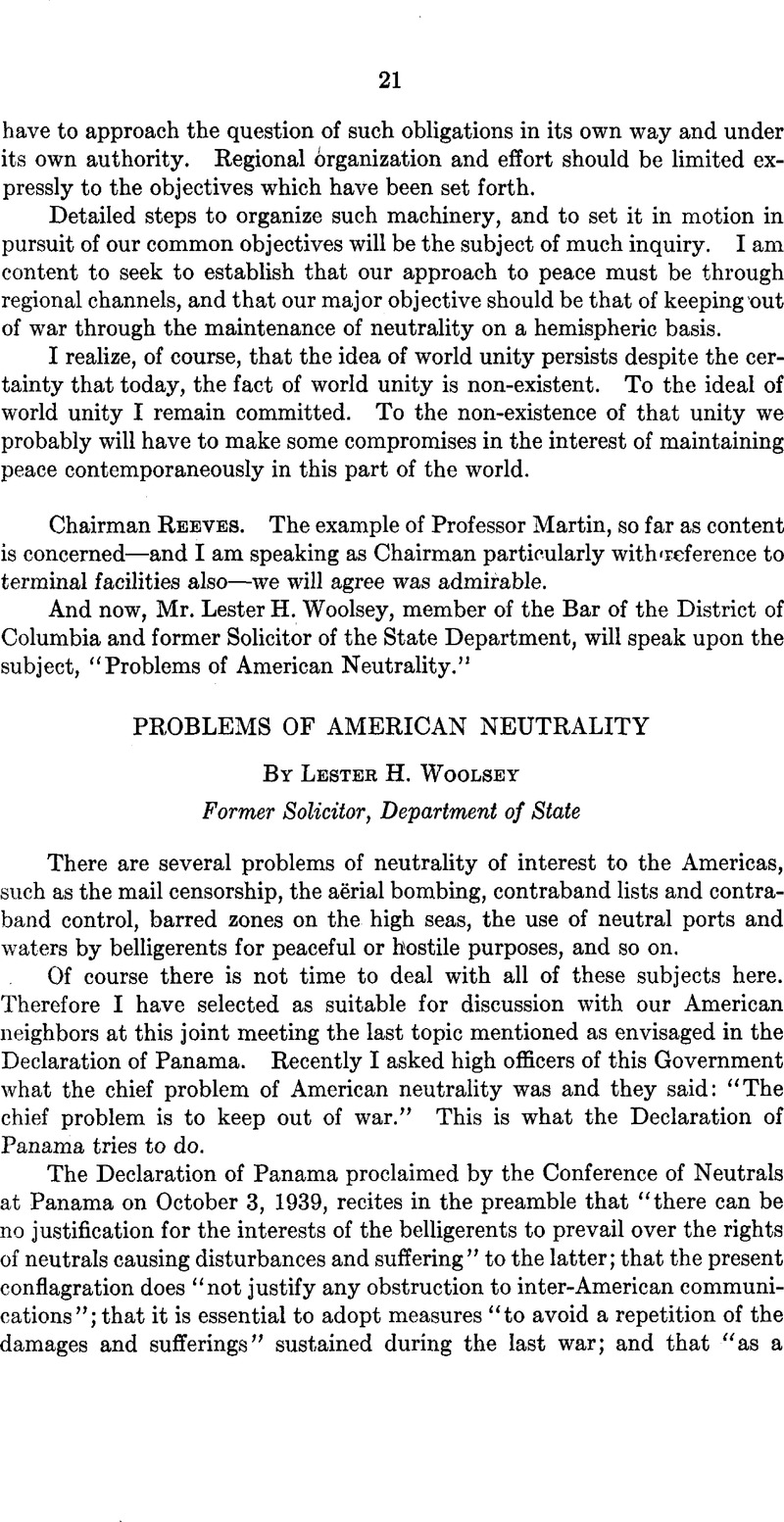No CrossRef data available.
Article contents
Problems of American Neutrality
Published online by Cambridge University Press: 27 February 2017
Abstract

- Type
- Second Session
- Information
- Copyright
- Copyright © American Society of International Law 1940
References
1 Aërial navigation may have had something to do with determining the width of the zone.
2 These proposals will be found in United States Foreign Relations, 1914, Supplement, pp. 434–452 Google Scholar.
3 Naval War College, 1917, p. 62.
4 It is evident that in policing an area of this size, perhaps containing five million square miles of open water, the American Republics could not do the job adequately.
5 These included the cases of the Dusseldorf, Ussukuma, and probably the Columbus and Arauca. The Hannover case occurred March 9, 1940, off the coast of the Dominican Republic.
6 The Fur Seal Arbitration with the same country expressly avoided the determination of the limit of “territorial waters” as such, but did hold the United States liable for damages for seals taken beyond the “ordinary three-mile limit.” (Moore, Arbitrations, p. 920.) There are other adjudications on this point.
7 Harvard Draft, p. 334. The Institute of International Law in 1928 called it a supplementary zone (zone supplémentaire), in which the state may take necessary measures for its security, neutrality, sanitation, customs and fisheries, but it declared that the zone supplémentaire should not extend beyond nine marine miles. (Annuaire of Institute for 1928.)
The League of Nations Committee of Experts for the Codification of International Law recommended that “beyond the zone of sovereignty states may exercise administrative rights on the ground of custom or of vital interest.” (Amer. Jour. Int. Law, Spec. Supp., Vol. 20 (1926), p. 141 Google Scholar.)
The American Institute of International Law in its draft of 1926 referred to a “supplementary distance of (blank) miles for reasons of security and in order to ensure the enforcement of customs and sanitary regulations.” (Cited by Brown, P. M., Amer. Jour. Int. Law, Vol. 34 (1940), p. 115 Google Scholar.)
8 Moore, , Digest of International Law, I, p. 723 Google Scholar.
9 In 1862 Spain complained about a Union warship’s cruising within the six-mile jurisdictional belt off the Cuban shore. The United States answered that Spain could not “exercise exclusive sovereignty upon the open sea beyond a line of three miles from the coast so as to deprive them of the rights common to all nations upon the open sea.” (Ibid., I, 706–8.) During the World War the United States complained repeatedly against the presence of belligerent cruisers off American harbors. The objection of the United States as a neutral was based “not upon the illegality of such action but upon the irritation which it naturally causes in a neutral country.” The practice was regarded “according to the canons of international courtesy, as a just ground for offence although it may be strictly legal.” (Secretary of State to British Ambassador, April 26, 1916, Amer. Jour. Int. Law, Spec. Supp., Vol. 10 (1916) p. 383 Google Scholar.)
10 Moore, , op. tit., Vol. I, p. 703 Google Scholar.
11 Commentaries, 1836, Vol. 1, p. 30.
12 Hearings, p. 217; cited by Jessup, , Amer. Jour. Int. Law, Vol. 33, (1939), p. 554 Google Scholar.
13 Garner, , International Law and the World War, Vol. I, p. 352 Google Scholar.
14 Naval War College, 1912, p. 114 et seq.
15 Ibid., 1914, p. 63.
16 Ibid., 1917, p. 233.
17 Phillimore, International Law, Vol. 3, Sec. 203.
18 Naval War College, 1912, p. 115.
19 The submarine mine appears to have been first successfully used by the Confederates, who mined their harbors and blew up several of the attacking and blockading ships during the Civil War.
20 Naval War College, 1912, p. 117.
21 Reservations were made by France, Britain and Germany.
22 Naval War College, 1912, p. 120.
23 Garner, , op. cit., Vol. I, pp. 329 350 Google Scholar.
24 Neutrality Draft, p. 707.
25 Warnings issued by the U. S. Hydrographic Office up to April 25, 1940.
26 For example, the Declaration of Paris of 1856 attempted to regulate the treatment of neutral goods in enemy ships and enemy goods in neutral ships, but in the World War these rules were almost nullified by the unilateral action of the Allies. The rule in this Declaration abolishing privateering was only a formal recognition that privateering was obsolete and no longer a valuable means of intercepting supplies to the/enemy. ( Rodgers, Admiral W. L. Amer. Jour. Int. Law, Vol. 33 (1939), pp. 442–443 Google Scholar.)
27 Fenwick, C. G., Amer. Jour. Int. Law, Vol. 34 (1940) 116–119 CrossRefGoogle Scholar.




